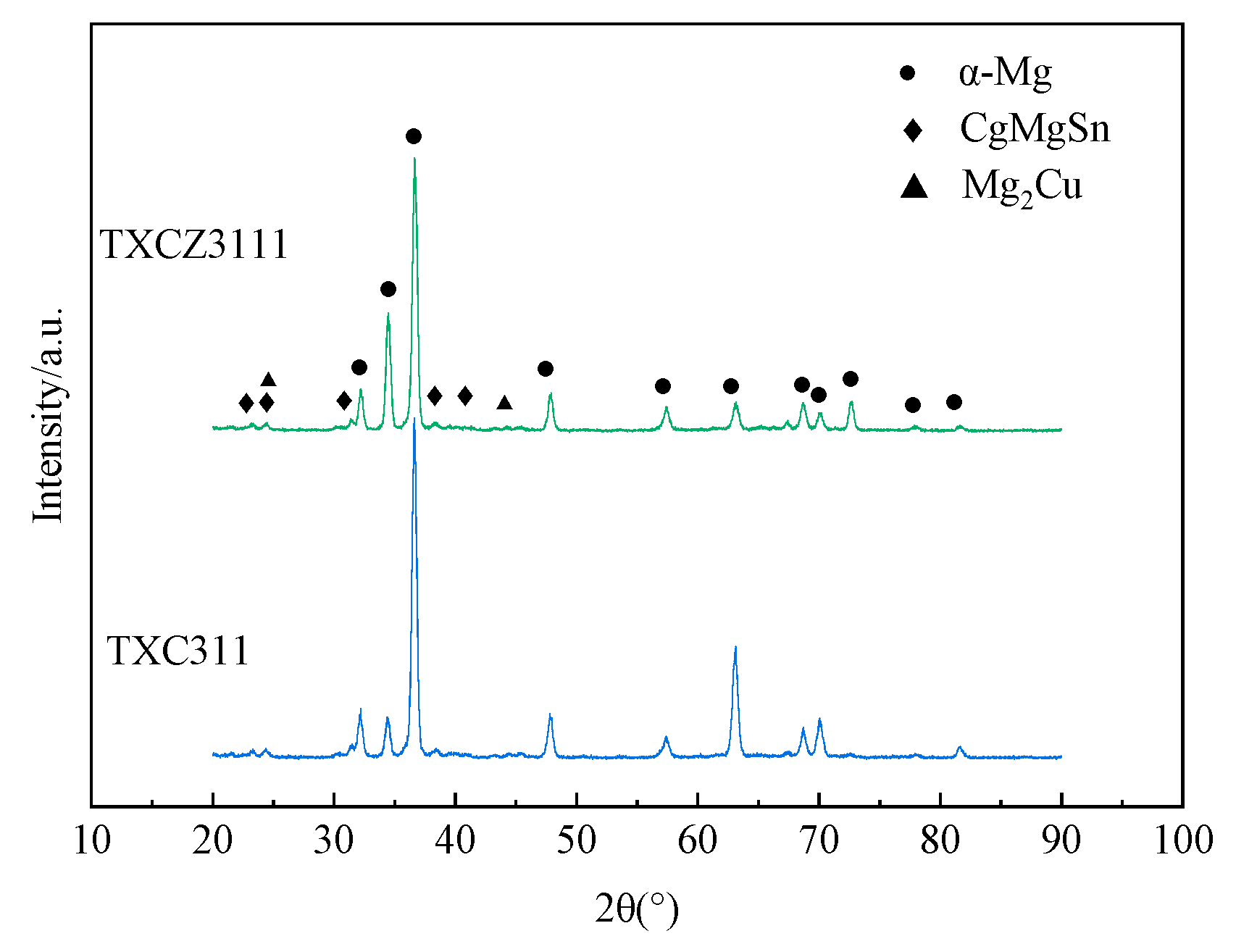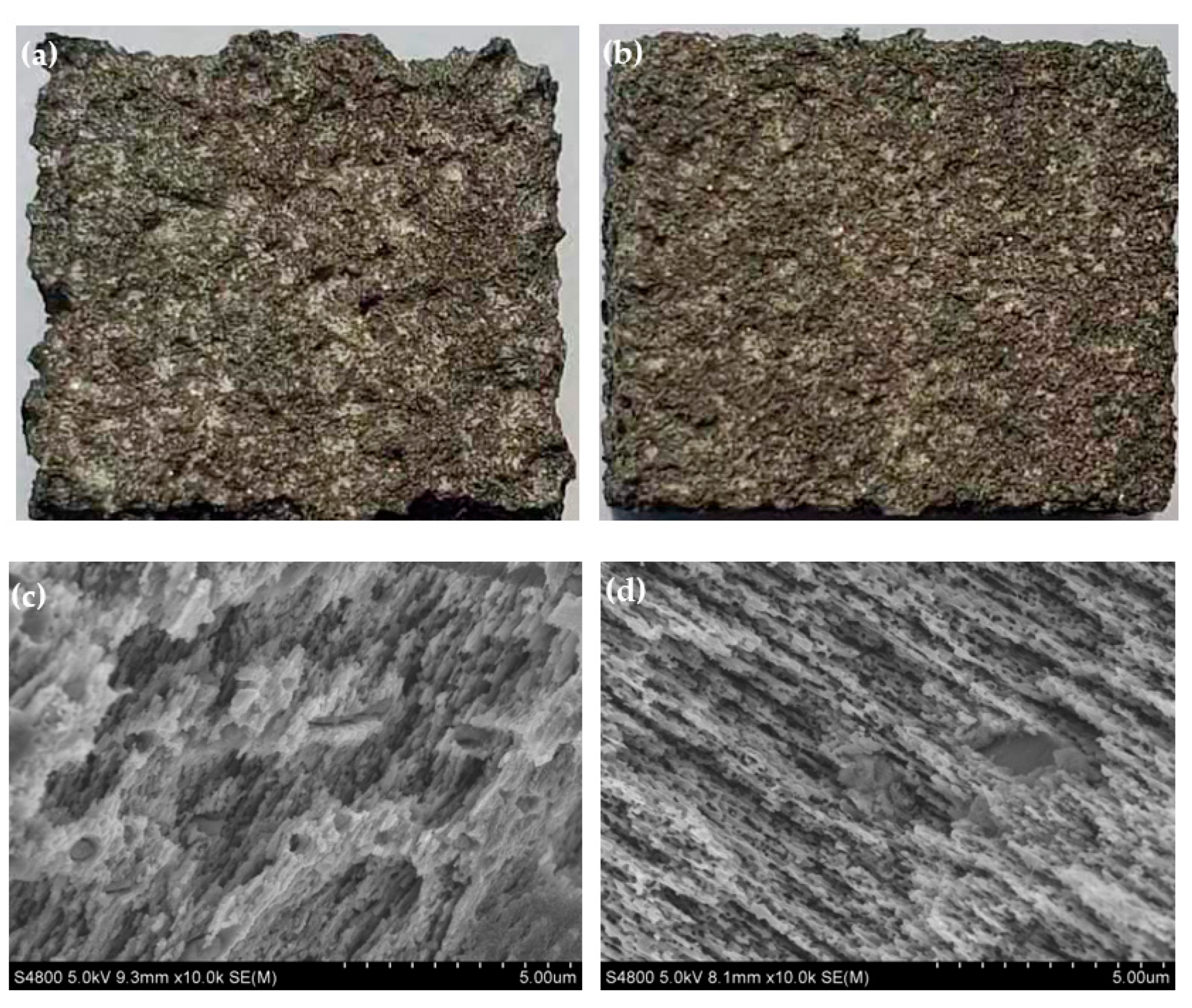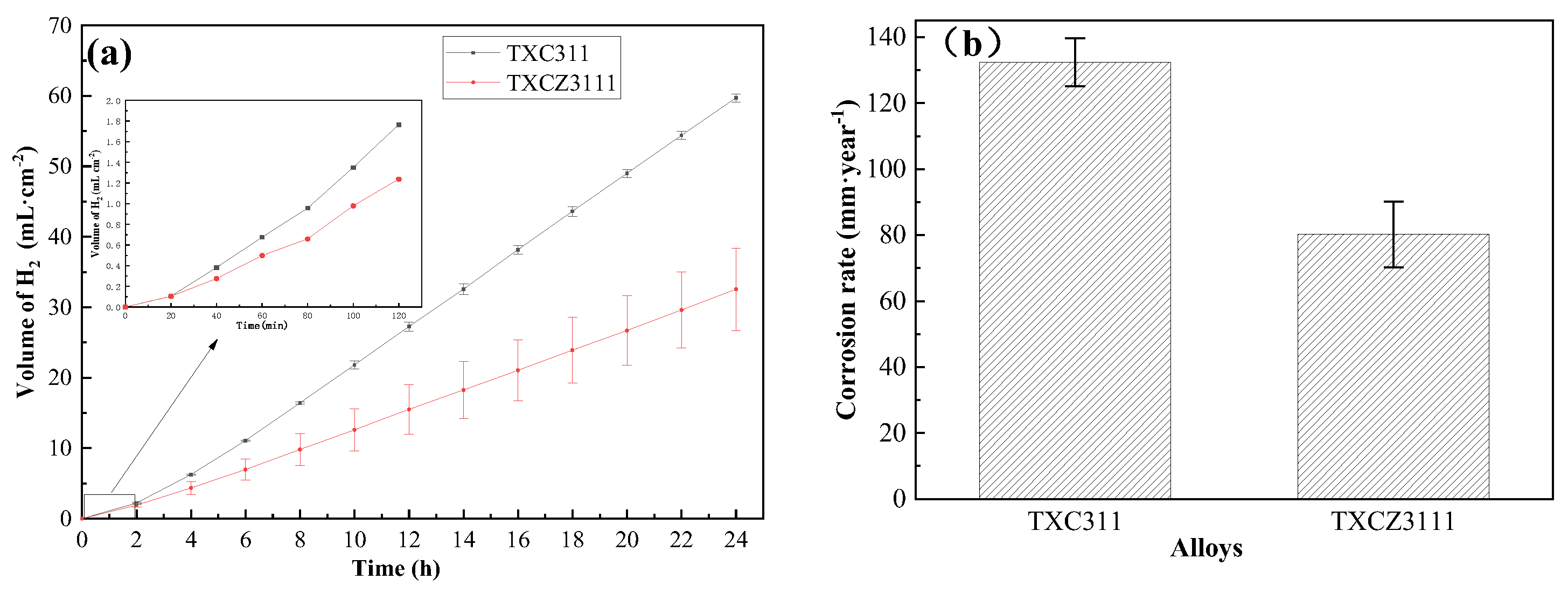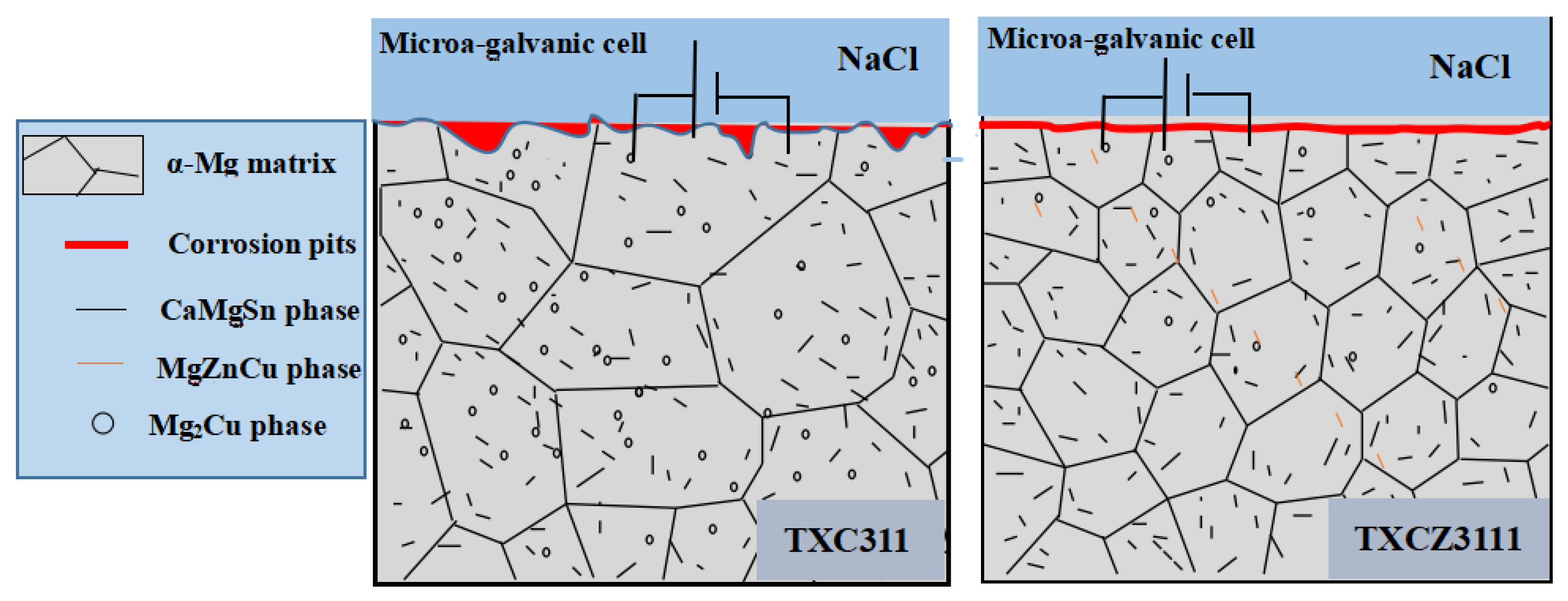Effects of Zn on Corrosion Properties of Homogenized Mg-3Sn-1Ca-1Cu Alloy
Abstract
:1. Introduction
2. Materials and Methods
3. Results and Discussions
3.1. Microstructure Evolution
3.2. Corrosion Properties
4. Conclusions
Author Contributions
Funding
Institutional Review Board Statement
Informed Consent Statement
Data Availability Statement
Conflicts of Interest
References
- Hongwei, R.; Jiangli, N.; Bo, X. Aging hardening behavior and Mechanism of Mg-Gd-Y Alloy with Different Strain Layers treated by Surface Mechanical Lapping. Rare Met. Mater. Eng. 2021, 50, 2577–2583. [Google Scholar]
- Jiang, P.; Blawert, C.; Bohlen, J.; Zheludkevich, M.L. Corrosion performance, corrosion fatigue behavior and mechanical integrity of an extruded Mg4Zn0.2Sn alloy. J. Mater. Sci. Technol. 2020, 59, 107–116. [Google Scholar] [CrossRef]
- Zhu, J.; Jia, H.; Liao, K.; Li, X. Improvement on corrosion resistance of micro-arc oxidized AZ91D magnesium alloy by a pore-sealing coating. J. Alloys Compd. 2021, 889, 161460. [Google Scholar] [CrossRef]
- Lu, D.; Jiang, Q.; Ma, X.; Fan, L.; Huang, Y.; Hou, B. Zinc chloride hydroxide—A recyclable diffusion source for fabrication of zinc rich coatings on magnesium alloys. J. Clean. Prod. 2022, 344, 131066. [Google Scholar] [CrossRef]
- Pan, H.; Qin, G.; Xu, M.; Fu, H.; Ren, Y.; Pan, F.; Song, B. Enhancing mechanical properties of Mg–Sn alloys by combining addition of Ca and Zn. Mater. Des. 2015, 83, 736–744. [Google Scholar] [CrossRef]
- Yangshan, S.; Kunzhong, W.; Guangyin, Y. Effect of Sn on microstructure and mechanical properties of magnesium alloy. Chin. J. Nonferrous Met. 1999, 9, 55–60. [Google Scholar]
- Boby, A.; Srinivasan, A.; Pillai, U.; Pai, B. Mechanical characterization and corrosion behavior of newly designed Sn and Y added AZ91 alloy. Mater. Des. 2015, 88, 871–879. [Google Scholar] [CrossRef]
- Kavyani, M.; Ebrahimi, G.R.; Ezatpour, H.R. Microstructure refinement, mechanical and biocorrosion properties of Mg-Zn-Ca-Mn alloy improved by a new severe plastic deformation process. J. Magnes. Alloys, 2021; in press. [Google Scholar] [CrossRef]
- Chang, L.; Tang, H.; Guo, J. Strengthening effect of nano and micro-sized precipitates in the hot-extruded Mg-5Sn-3Zn alloys with Ca addition. J. Alloys Compd. 2017, 703, 552–559. [Google Scholar] [CrossRef]
- Rashed, H.M.M.A.; Mesbah, M.B. Effects of Sn addition on dynamic grain growth in a binary Mg-1Ca alloy. Mater. Res. Express 2021, 8, 1–10. [Google Scholar] [CrossRef]
- Zhang, Y.; Chen, X.Y.; Lu, Y.L.; Li, X.P. Microstructure and mechanical properties of as-extruded Mg-Sn-Zn-Ca alloy with different extrusion ratios. Trans. Nonferrous Met. Soc. China 2018, 28, 2190–2198. [Google Scholar] [CrossRef]
- Luo, A.; Pekguleryuz, M.O. Cast magnesium alloys for elevated temperature applications. J. Mater. Sci. 1994, 29, 5259–5266. [Google Scholar] [CrossRef]
- Buha, J.; Ohkubo, T. Natural Aging in Mg-Zn(-Cu) Alloys. Metall. Mater. Trans. A 2008, 39, 2259–2273. [Google Scholar] [CrossRef]
- Zhu, H.M.; Luo, C.P.; Liu, J.W.; Jiao, D.L. Growth twinning behavior of cast Mg-Zn-Cu-Zr alloys. Trans. Nonferrous Met. Soc. China 2014, 24, 316–320. [Google Scholar] [CrossRef]
- Wang, J.; Liu, R.; Luo, T.; Yang, Y. A high strength and ductility Mg-Zn-Al-Cu-Mn magnesium alloy. Mater. Des. 2013, 47, 746–749. [Google Scholar] [CrossRef]
- Lotfpour, M.; Emamy, M.; Dehghanian, C.; Tavighi, K. Influence of Cu Addition on the Structure, Mechanical and Corrosion Properties of Cast Mg-2%Zn Alloy. J. Mater. Eng. Perform. 2017, 26, 1–15. [Google Scholar] [CrossRef]
- Ha, H.Y.; Kang, J.Y.; Yim, C.D.; Yang, J.; You, B. S Role of hydrogen evolution rate in determining the corrosion rate of extruded Mg-5Sn-(1-4wt%)Zn alloys. Corros. Sci. 2014, 89, 275–285. [Google Scholar] [CrossRef]
- Wang, C.; Guo, S.; Zeng, L.; Zheng, D.; Xu, J.; Yang, M.; Liang, T. Effects of Second Phases on Microstructure, Microhardness, and Corrosion Behavior of Mg-3Sn-(1Ca) Alloys. Materials 2019, 12, 2515. [Google Scholar] [CrossRef] [Green Version]
- Chai, Y.; He, C.; Jiang, B.; Fu, J.; Jiang, Z.; Yang, Q.; Pan, F. Influence of minor Ce additions on the microstructure and mechanical properties of Mg-1.0Sn-0.6Ca alloy. J. Mater. Sci. Technol. 2020, 37, 26–37. [Google Scholar] [CrossRef]
- Shi, Z.; Atrens, A. An innovative specimen configuration for the study of Mg corrosion. Corros. Sci. 2011, 53, 226–246. [Google Scholar] [CrossRef]
- Zhao, M.C.; Deng, Y.L.; Zhang, X.M. Strengthening and improvement of ductility without loss of corrosion performance in a magnesium alloy by homogenizing annealing. Scr. Mater. 2008, 58, 560–563. [Google Scholar] [CrossRef]
- Kwon, J.; Baek, S.M.; Jung, H.; Kim, J.C.; Lee, S.Y.; Park, S.S. Role of microalloyed Sm in enhancing the corrosion resistance of hot-rolled Mg-8Sn-1Al-1Zn alloy. Corros. Sci. 2021, 185, 109425. [Google Scholar] [CrossRef]
- Yin, S.; Duan, W.; Liu, W.; Wu, L.; Yu, J.; Zhao, Z.; Zhang, Z. Influence of specific second phases on corrosion behaviors of Mg-Zn-Gd-Zr alloys. Corros. Sci. 2020, 166, 108419. [Google Scholar] [CrossRef]
- Hu, T.; Xiao, W.; Wang, F.; Li, Y.; Lyu, S.; Zheng, R.; Ma, C. Improving tensile properties of Mg-Sn-Zn magnesium alloy sheets using pre-tension and ageing treatment. J. Alloys Compd. 2018, 735, 1494–1504. [Google Scholar] [CrossRef]
- Jiang, P.; Blawert, C.; Scharnagl, N.; Bohlen, J.; Zheludkevich, M.L. Mechanistic understanding of the corrosion behavior of Mg4Zn0.2Sn alloys: From the perspective view of microstructure. Corros. Sci. 2020, 174, 108863. [Google Scholar]
- Baek, S.M.; Kang, J.S.; Kim, J.C.; Kim, B.; Shin, H.J.; Park, S.S. Improved corrosion resistance of Mg-8Sn-1Zn-1Al alloy subjected to low-temperature indirect extrusion. Corros. Sci. 2018, 141, 203–210. [Google Scholar] [CrossRef]
- Wang, X.W.; Wang, W.; Chen, W.; Chen, D.M. Effect of Al addition and heat treatment on the microstructures and corrosion resistance of Mg-Cu alloys. J. Mater. Sci. Technol. 2018, 98, 219–232. [Google Scholar] [CrossRef]
- Lotfpour, M.; Dehghanian, C.; Emamy, M.; Bahmani, A.; Malekan, M.; Saadati, A.; Taghizadeh, M.; Shokouhimehr, M. In-vitro corrosion behavior of the cast and extruded biodegradable Mg-Zn-Cu alloys in simulated body fluid (SBF). J. Magnes. Alloys 2021, 8, 2078–2096. [Google Scholar] [CrossRef]







| Alloy | Mg | Sn | Ca | Cu | Zn |
|---|---|---|---|---|---|
| Mg-3Sn-1Ca-1Cu (TXC311) | Bal. | 3.22 | 1.04 | 1.07 | |
| Mg-3Sn-1Ca-1Cu-1Zn (TXCZ3111) | Bal. | 3.18 | 1.04 | 1.04 | 1.07 |
| Alloy | Ecorr/V | Icorr/uA. cm2 | Pi (mm/Year) | Rs Ω cm2 | CPEdl | Rct Ω cm2 | CPEf | Rf Ω cm2 | RL Ω cm2 | L H. cm2 | ||
|---|---|---|---|---|---|---|---|---|---|---|---|---|
| Y1/μΩ−1·cm−2·Sn | n1 | Y2/μΩ−1·cm−2·Sn | n2 | |||||||||
| TXC311 | −1.479 ± 0.009 | 88.9 ± 10.2 | 2.03 ± 0.23 | 2.61 ± 0.34 | 8.68 ± 1.35 | 0.89 ± 0.02 | 4.67 ± 0.23 | 385 ± 13.32 | 0.91 ± 0.03 | 29.53 ± 4.13 | 30.67 ± 2.61 | 368.4 ± 30.55 |
| TXCZ3111 | −1.457 ± 0.0015 | 43.7 ± 5.3 | 0.98 ± 0.03 | 2.80 ± 0.25 | 1.63 ± 0.36 | 0.87 ± 0.02 | 3.10 ± 0.15 | 276 ± 9.96 | 0.90 ± 0.02 | 55.16 ± 5.56 | 95.05 ± 10.56 | 1683 ± 155.78 |
Publisher’s Note: MDPI stays neutral with regard to jurisdictional claims in published maps and institutional affiliations. |
© 2022 by the authors. Licensee MDPI, Basel, Switzerland. This article is an open access article distributed under the terms and conditions of the Creative Commons Attribution (CC BY) license (https://creativecommons.org/licenses/by/4.0/).
Share and Cite
Jia, Z.; Yu, B.; Wang, Z.; Han, X.; Fu, L. Effects of Zn on Corrosion Properties of Homogenized Mg-3Sn-1Ca-1Cu Alloy. Crystals 2022, 12, 660. https://doi.org/10.3390/cryst12050660
Jia Z, Yu B, Wang Z, Han X, Fu L. Effects of Zn on Corrosion Properties of Homogenized Mg-3Sn-1Ca-1Cu Alloy. Crystals. 2022; 12(5):660. https://doi.org/10.3390/cryst12050660
Chicago/Turabian StyleJia, Zheng, Bing Yu, Zhizhuo Wang, Xu Han, and Li Fu. 2022. "Effects of Zn on Corrosion Properties of Homogenized Mg-3Sn-1Ca-1Cu Alloy" Crystals 12, no. 5: 660. https://doi.org/10.3390/cryst12050660





